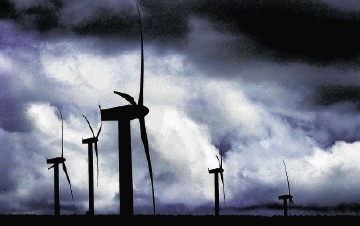
After years of false starts, U.S. offshore wind has attracted some marquee names with deep pockets, creating a sense of optimism for the emerging industry.
“These are big, well-capitalized companies that are unlikely to fail,” Bryan Martin, a managing director at D.E. Shaw & Co., said during a presentation at the U.S. Offshore Wind Leadership Conference in Boston.
D.E. Shaw, a $39 billion hedge fund, is the principal owner of Deepwater Wind LLC, which expects to complete this year the first wind farm in U.S. waters. It’s joined by Dong Energy A/S of Denmark, the world’s largest offshore-wind developer, which is scouting for sites up and down the East Coast. So is Offshore MW LLC, a New Jersey developer backed by the private equity behemoth Blackstone Group LP.
Progress has been slow to come for offshore wind developers in the U.S., even as the industry has thrived in Europe for more than a decade. These massive power projects typically cost more than $1 billion to plan and build, and wind companies and investors are seeking similar opportunities in the U.S.
‘New Opportunity’
“There is a new opportunity that didn’t exist even a few years ago for U.S. offshore wind,” said Matt Morrissey, managing director of Offshore Wind Massachusetts, a coalition pushing for projects in New England.
The moves by Dong, Blackstone and other significant companies into U.S. offshore wind shows that the industry has evolved from its early days of failed projects, said Erich Stephens, executive vice president of Offshore MW.
“Dong is sort of the ultimate epitome of that arrival,” Stephens said. “It shows that there is a level of maturity and sophistication.” Offshore MW is looking at sites in New Jersey, Massachusetts and New York waters.
Dong opened a U.S. office in Boston in July, and the Danish company has touted its balance sheet and scale as competitive advantages that will help it bring down costs as the U.S. market expands.
Costs Doubled
The chief hurdle for offshore projects has been the cost of building at sea, which is about double what it takes to install turbines on land. Developers at this week’s conference say the growing number of offshore wind players in the U.S. is introducing an element that may finally push the industry out of the gate: competition. As more companies compete to build in U.S. waters, they will find innovative ways to finance projects and cut costs, much as oil drillers did in the Gulf of Mexico during the 1970s, developers said.
“Competition is a very healthy thing for driving prices down. And that’s why the market needs to be big enough in the states,” said Jim Sandon, chief operating office of Renewable Energy Systems Ltd., a Hertfordshire, U.K.-based developer.
The U.S. offshore wind industry is growing faster than General Electric Co. expected, according to Anders Soe-Jensen, chief executive officer of the company’s offshore wind unit.
“The U.S. offshore market is going to take off actually before we had predicted, which was 2025,” Soe-Jensen said. “I am very optimistic about the U.S. market.”
Recommended for you
